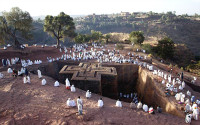Divine Ethiopia
Its landscapes are biblical and its rituals haven’t changed for centuries. But amid the cave churches and primitive tribes are new lodges – and helicopters (or donkeys) to reach them.
By stanley Stewart, The Telegraph
Sunday Service in the church of Abuna Yemata Guh requires nerves of steel. Yet they assured me the congregations were good. “Don’t worry,” the priest fussed. “Pregnant women are attending, old people are attending, tiny children are attending.”
I wasn’t sure I would be attending. I was standing on a narrow ledge. Below me was a 1,000ft drop to the valley floor. Somewhere above me, beyond a sheer polished cliff, was the church. My legs felt like water. I was sweating in places I had never sweated before. At that moment, the eye of a needle seemed easier to negotiate. “You must try,” the priest whispered. “God is watching.”
There are moments when Ethiopia seems to belong to an atlas of the imagination – part legend, part fairy-tale, part Old Testament book, part pulling your leg. In this land of wonders there are medieval castles of a black Camelot, monasteries among Middle Earth peaks accessible only by rope and chains, the ruined palace of the Queen of Sheba and the original Ten Commandments in a sealed box guarded by mute monks with killer instincts.
In the northern highlands priests with white robes and shepherds’ crooks appear to have stepped out of a Biblical painting. In the southern river valleys bare-breasted tribeswomen, who scar their torsos for erotic effect and insert plates the size of table mats in their lower lips, seemed to have emerged from a National Geographic magazine circa 1930. Ethiopia “resembles no other country in Africa”, wrote the great explorer Wilfred Thesiger, “or anywhere else.”
Read more at: The Telegraph




